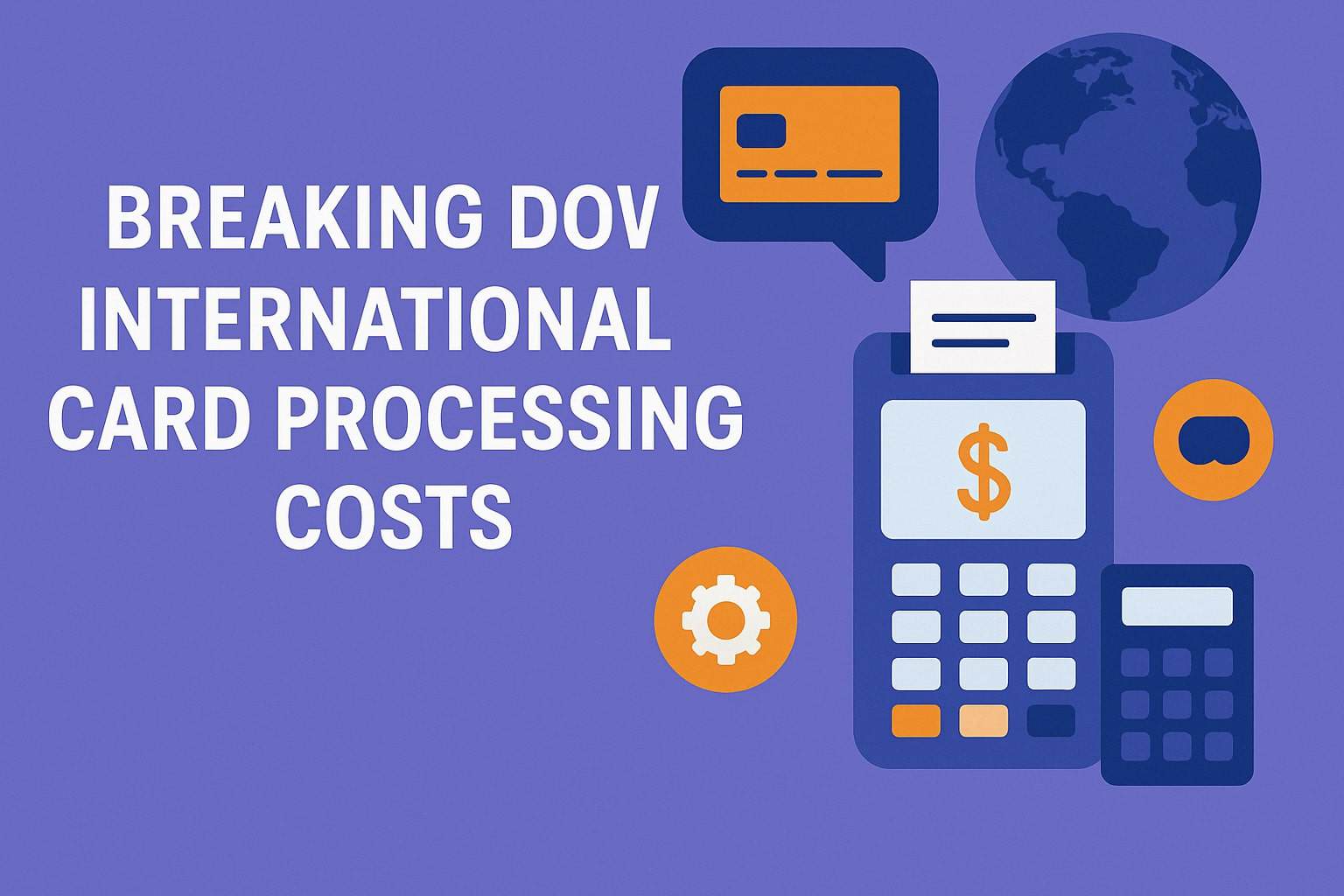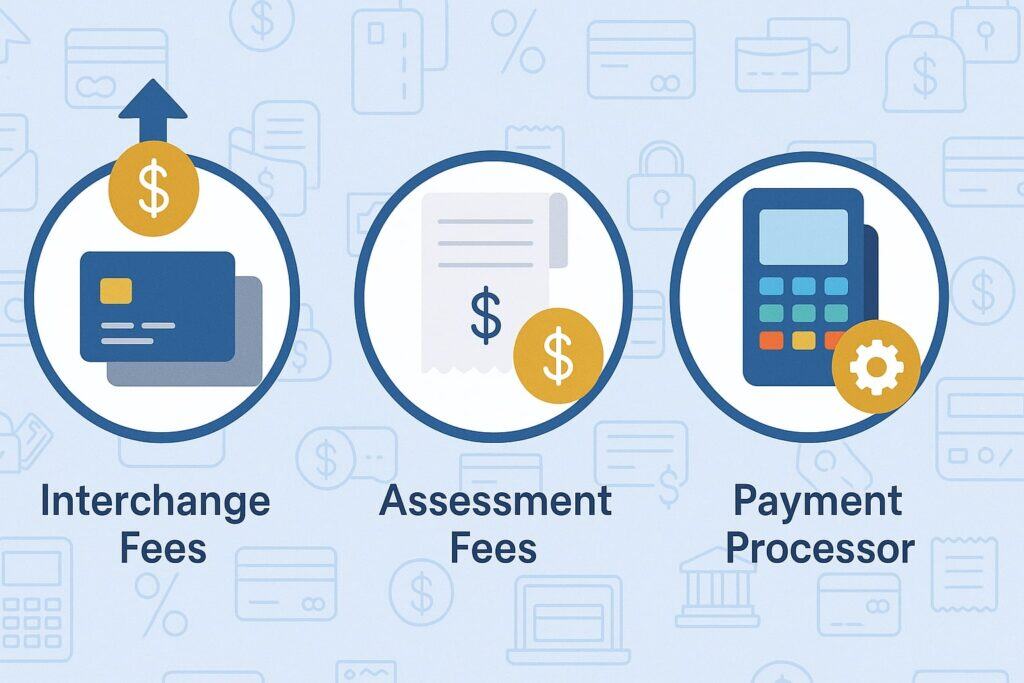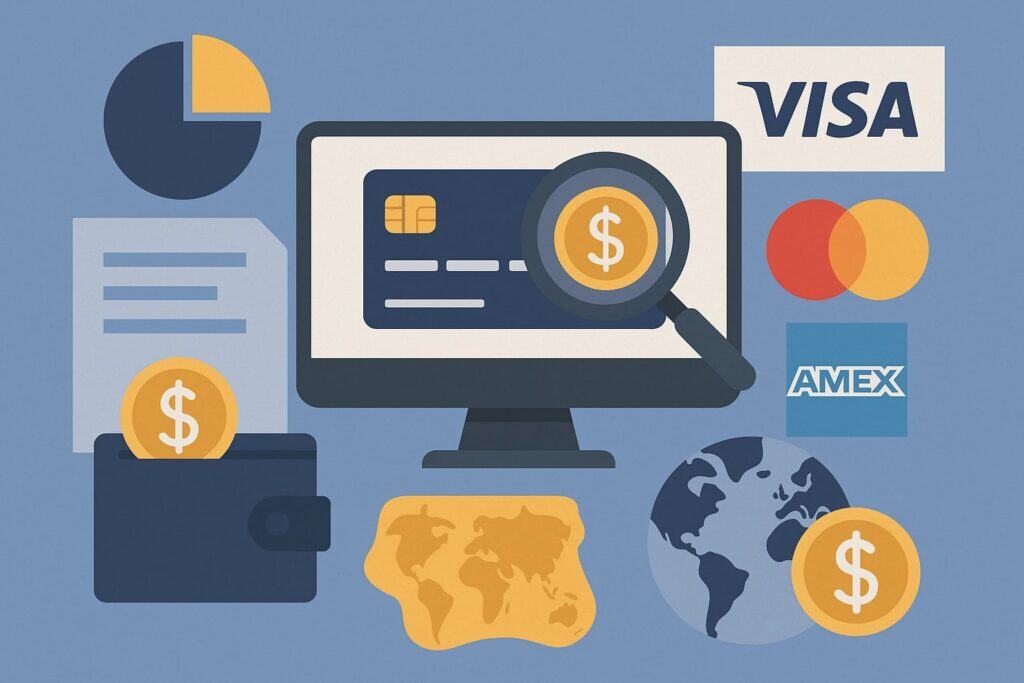
By crossborderfees September 27, 2025
Accepting international credit and debit card payments exposes U.S. businesses to additional fees beyond domestic transactions. Breaking down international card processing costs means understanding interchange fees, network assessments, and processor markups that apply when cards are issued or settled overseas.
These costs typically include cross-border or foreign transaction surcharges by card networks (Visa, Mastercard, Amex, Discover), currency conversion fees on non-USD payments, and the payment provider’s own markups.
In general, credit card processing fees run about 1.5%–3.5% of a sale, but international transactions can add 1–3% or more on top due to these extra surcharges.
For example, Visa’s International Service Assessment (ISA) is 1.00% for USD transactions and 1.40% for non-USD transactions. In short, breaking down international card processing costs helps merchants identify where these added charges come from and how to manage them.
Core Components of Card Processing Costs

Every credit/debit card transaction involves three parties that each take a cut: the issuing bank, the card network, and the payment processor. The interchange fee (paid to the card-issuing bank like Chase or Citi) is typically the largest portion—often 70–80% of the total fee.
Interchange rates depend on card type (credit vs. debit), transaction method (card-present vs. online), and card features (rewards, corporate, etc.).
For example, a domestic Visa or Mastercard reward credit card might carry an interchange rate around 1.7–1.9%, whereas a domestic debit card (regulated by law) may be as low as 0.05% plus a small fixed amount.
The network assessment (or association) fee goes to card networks like Visa, Mastercard, Discover, and American Express. These are usually a small percentage (often 0.10–0.15% of volume) or a flat per-transaction fee.
For example, Discover charges a standard 0.13% assessment on volume. Card networks also impose special cross-border or international service fees on transactions involving cards issued abroad. These can range from around 0.60% up to 1.40%, depending on the network (see below).
The third component is the payment processor’s markup. This is the fee the processor (Stripe, Square, a merchant account provider, etc.) adds on top of the wholesale costs. The processor can charge a fixed per-transaction fee, a percentage, or both.
Unlike interchange and assessment fees (which are set by networks and banks), the processor’s markup is negotiable to some extent and varies by pricing model.
Broadly, processors offer flat-rate plans (e.g. “2.9%+30¢ per transaction”) or interchange-plus plans (passing through interchange/assessments and tacking on a fixed margin). For example, Square charges a flat 2.6%+15¢ for in-person card swipes, while Stripe’s standard plan is 2.9%+30¢ plus 1.5% for international cards.
In summary, a merchant’s total fee ≈ Interchange + Assessments + Processor Markup. Because interchange is fixed, comparing providers mainly comes down to the processor’s markup and how they bundle fees.
Flat-rate services (Square, PayPal) hide the components but often charge extra for international use, whereas interchange-plus providers (Stripe, traditional merchant accounts) itemize each fee.
Domestic vs. International Transactions

Domestic transactions occur when a U.S. merchant accepts a card issued by a U.S. bank and settles in USD. In these cases, only the standard interchange and network fees apply.
International transactions happen if either the card is issued outside the U.S. or the transaction is settled in a foreign currency. Such transactions can trigger extra charges known as cross-border fees or foreign transaction fees.
Practically, these two terms are often interchangeable. As one payment industry guide explains, a cross-border fee (or foreign transaction fee) applies when a purchase is processed through a foreign bank or in a foreign currency.
These international surcharges have two components. First, the card network imposes its own cross-border assessment on merchants.
For instance, Visa adds an International Service Assessment (ISA) of 1.0% when the merchant is in one country and the card-issuing bank is in another (settling in USD) and 1.4% if settled in a foreign currency.
Mastercard charges 0.60% in USD and 1.00% for non-USD cross-border transactions. Discover’s international service fee is 0.80%, plus a 0.50% “processing” fee for non-US issuers.
American Express charges an Inbound Fee of about 1.0% on Amex cards issued outside the U.S.. These fees are assessments by the networks and are generally passed through to the merchant via the processor.
Second, if the sale involves currency conversion, there may be a currency conversion fee. This fee covers the cost of converting one currency to another. For example, Stripe adds +1.0% if currency conversion is required.
PayPal typically includes a currency markup of around 3–4% on top of exchange rates (in addition to its base rate) for cross-border sales. In general, foreign transaction fees (for currency conversion) range around 1%–3%, though some issuers charge higher.
So a U.S. merchant accepting a foreign card may see both a network cross-border fee (~1%) and a conversion fee (often 1–4%) on top of the regular processing rate.
Overall, international card processing costs are significantly higher than domestic ones. One industry analysis notes these surcharges “generally range from 1% to 3% of the transaction amount”.
For example, a $100 sale might incur $1–3 in cross-border fees (network assessments) plus any currency conversion margin. These extra costs make global transactions more expensive for the merchant. Understanding each component (interchange, network, conversion) is key to breaking down the total cost of an international card transaction.
Cross-Border Fees by Card Network

Each card brand sets its own international fees:
- Visa (International Service Assessment) – 1.00% if the transaction is in USD with a non-U.S. issuer, and 1.40% if it’s settled in the cardholder’s foreign currency. (In other words, Visa charges 1.4% for cross-border sales in non-USD.) Visa also charges an International Acquirer Fee (IAF) of 0.40%, but many merchants see only the bundled ISA total.
- Mastercard (Cross-Border Fee) – 0.60% for USD-settled cross-border sales (card and merchant in different countries) and 1.00% for cross-border sales in another currency. Mastercard does not have a separate IAF like Visa; the above rates are its global cross-border assessments.
- American Express (International Assessment) – About 1.00% on U.S. merchant transactions if the Amex card was issued outside the U.S.. (Amex used to charge ~0.40% but raised it to 1% in 2022.) This “Inbound Fee” is in addition to Amex’s normal interchange. (Note: Amex’s published rates on merchant statements may combine these fees.)
- Discover (International Service Fee) – 0.80% for transactions where the card issuer is outside the U.S.. In practice, Discover’s fees are split into a 0.80% service fee plus a 0.50% “international processing” fee (as shown on some statements).
These network fees are assessment fees that go to the card brand. They are passed to the merchant by the processor. For example, if a U.S. customer uses a European-issued Visa card, the Visa ISA of 1.0–1.4% will be added on top of the interchange fee.
Note that some processors absorb small fees or round them differently, but most clearly itemize or include them in surcharges. In any case, merchants should expect roughly a 1–2% surcharge per transaction for cross-border cards.
Currency Conversion Fees
When a transaction involves currency conversion, additional costs can occur. If a U.S. merchant accepts payment in a foreign currency (or the card is foreign and the processor settles in USD), the payment processor or card network may charge a foreign exchange fee.
Typically this is a percentage of the amount (often 1–3%). For instance, Stripe adds +1.0% of the amount for any payment requiring currency conversion. Other providers similarly tack on a 2–4% currency fee.
Besides the explicit fee, there is often a spread on the exchange rate. The processor buys the foreign currency at one rate and credits the merchant in USD at a slightly less favorable rate, effectively pocketing a markup.
This implicit markup can be a few percent as well. In total, foreign conversion costs (fee + spread) typically range 1–3%. For example, if a French customer pays €100 at a USD checkout, the €100 is converted to about $108 (market) but the merchant may receive $105 after a 2% conversion fee.
Merchants can minimize currency costs by using multi-currency accounts or pricing tools. For instance, Stripe and PayPal allow charging customers in their home currency and holding balances in multiple currencies.
Then the merchant decides when (and at what rate) to convert funds. Avoiding unwanted conversion fees can significantly reduce international card processing costs on large cross-border volumes.
Pricing Models: Flat-Rate vs. Interchange-Plus vs. Tiered
Payment providers package the underlying fees into different models:
- Flat-Rate Pricing: A single rate is charged for all transactions. This is simple but often higher for cross-border or high-risk sales.
For example, Square’s flat rate is 2.6%+15¢ per in-person transaction, and 2.9%+30¢ for online. PayPal’s basic rate is 2.99%+30¢ for domestic transactions, plus a fixed foreign fee and +1.5% if the payer is international.
Flat rates may include most fees in one bucket, but they tend to be more expensive for high-ticket or cross-border transactions because the surcharge is built in. - Interchange-Plus (Pass-Through): The processor passes the exact interchange and assessment fees to the merchant and then adds a small markup. For example, a provider might charge “Interchange + 0.50% + $0.10.”
This model is highly transparent. A merchant on interchange-plus would see Visa/MC cross-border surcharges of ~1% plus the small processor margin. High-volume merchants often prefer this to minimize total costs.
Providers like Stripe (with Custom/Enterprise pricing) and merchant accounts through banks typically use interchange-plus. Adyen, for instance, uses interchange-plus with markups starting around $0.13 + 0.60% for Visa/MC (negotiable). - Tiered Pricing: Processors with tiered plans categorize transactions into “qualified,” “mid-qualified,” and “non-qualified” tiers based on preset rules. Each tier has its own rate (e.g. “qualified” swiped Visa vs “non-qualified” keyed Amex).
Merchants often pay higher average rates because favorable interchange can be hidden in “qualified” buckets. Tiered pricing can obscure exactly which network fees apply. It’s generally not recommended for savvy merchants, as it often means overpaying on international or manually-entered transactions.
Key Insight: Regardless of model, the underlying interchange fees are the same across providers. So when comparing international fees, focus on the processor’s markup and any additional cross-border charges. Flat-rate providers may charge e.g. 3.3% for cross-border online sales, while interchange-plus providers will charge ~1% network fee + small margin.
Comparing Major Providers
- Stripe: Stripe’s standard U.S. pricing is 2.9% + $0.30 per domestic card payment, plus +1.5% for cards issued outside the U.S.. If currency conversion is needed, Stripe adds another +1.0%.
Thus a cross-border, currency-converted card could cost 4.4% total (2.9+1.5) plus $0.30 plus 1.0% conversion fee. For in-person (Stripe Terminal), Stripe charges 2.7% + $0.05 plus the same +1.5% international fee.
Stripe uses an interchange-plus model under the hood and passes network fees transparently. For high-volume merchants, Stripe offers custom pricing (interchange-plus) with negotiable markups below the standard 2.9%. - Square: Square has a simple flat-rate model. In-person swiped/chip/contactless transactions cost 2.6% + $0.10–15¢ (depending on device). Online transactions via Square’s API are 2.9%+30¢.
Square explicitly states it does not charge additional fees for foreign cards; international cards are accepted with the same flat rate. However, Square does not support multi-currency pricing in a single account.
If a transaction is in a currency other than your account’s currency (USD), Square will convert it to USD (using its FX rate) and then apply the flat fee. In effect, Square’s flat rate covers all credit, debit, and international cards.
This simplicity benefits small sellers, but on high-ticket or many foreign transactions a flat 2.6–2.9% can be more expensive than interchange-plus. - PayPal: PayPal’s US business accounts charge a base rate of 2.99% + $0.49 (or depending on product, typically ~30¢) for domestic card payments. On top of that, PayPal adds +1.50% for cross-border transactions.
For example, a sale from a U.S. merchant to a customer in another country would be about 4.49% + fixed fee. PayPal also charges a 2.5–4% currency conversion fee on top of the USD conversion.
While not the cheapest, PayPal’s strength is ubiquity. It’s easy to add PayPal Checkout to any site. For high volumes, PayPal/Maintenance also offers Payflow Pro or Braintree (both interchange-plus options) which can reduce costs. - Adyen: Adyen is an example of a global processor using interchange-plus. It’s common in Europe but supports U.S. merchants too. Adyen’s published rates for Visa/MC start at $0.13 + 0.60% per transaction, plus the actual interchange.
Because Adyen is transparent, a U.S. merchant would see Visa’s 1.0–1.4% cross-border fee plus Adyen’s 0.6%. Adyen negotiates lower markups for large merchants (often down to 0.25–0.50%). In effect, Adyen can be cheaper than flat-rate for very high volume, but it requires careful reading of statements. - Traditional Merchant Accounts: Banks like Chase/Worldpay, Wells Fargo, FIS, etc., offer merchant services with interchange-plus pricing. Fees here vary by bank and merchant relationship. Generally, U.S. merchant accounts might charge a flat monthly fee ($10–$30) plus per-transaction fees (often interchange + 0.2 – 0.5% + a few cents).
These providers also pass through network cross-border fees. For example, a Visa transaction from a German card would incur Visa’s 1.0% ISA, a Mastercard 0.6% fee, and possibly a small bank markup.
Some acquirers bundle level 2/3 data differently, but in principle the cost is interchange + a modest margin.
Braintree (PayPal subsidiary) – Offers pricing similar to PayPal (2.59% + 49¢ for domestic, +1.5% international). It allows integration like Stripe. As a PayPal product, it also uses flat-ish fees plus extra for cross-border cards.
Comparative Rates: In practice, you’ll see retailers say: Square: ~2.6–2.9% flat; Stripe: 2.9%+30¢ (+1.5% intl); PayPal: 2.99% (+1.5% intl); Adyen: ~0.60% + interchange; Worldpay: ~0.30% + interchange.
The cheapest option depends on volume and card mix. Small businesses often choose flat rates for simplicity, but high-volume/large-ticket businesses typically save money with interchange-plus pricing.
Reducing International Processing Costs
Breaking down these costs helps identify savings:
- Use Interchange-Plus Pricing: If possible, negotiate with your processor for interchange-plus terms. Even small merchants can often get margins of 0.40–0.70% instead of 2–3%. With pass-through pricing, you only pay the actual network fees plus a low fixed markup.
- Enable Multi-Currency: Accept payments in the customer’s currency. Many gateways (Stripe, Adyen, Authorize.net, PayPal) allow multi-currency. Charging in local currency may reduce currency conversion charges for customers and allows you to control conversion. For example, a European buyer charged in EUR avoids double conversion.
- Choose Local Processing: If you have high volume from a particular country, consider a local merchant account or a payment partner in that region. This can eliminate cross-border surcharges entirely. (This is often done by large platforms.)
- Check Card Types: Encourage use of debit or low-issue-cost cards for international sales. For example, Visa and MC debit cards often have lower interchange (and sometimes networks waive ISA on regulated debits), whereas rewards credit cards carry higher rates.
- Negotiate with Acquirers: If you use a bank merchant account, ask if they can waive or reduce any cross-border fees on high volume. (Some may include cross-border in a bundled rate for key clients.)
- Use No-Fee Cards for Expenses: On the issuing side, using corporate cards with no foreign transaction fee (e.g. Capital One) can save businesses. But for merchant fees, focus on what the processor charges you, not cardholder fees.
- Review Merchant Statements: Ensure you understand every line item. Look for “other fees” or “cross-border” on statements. Confirm that your rates match your contract (e.g. flat-rate plans should not list interchange separately).
By understanding each component (interchange, assessment, markup, conversion), businesses can make informed choices about providers and pricing plans. Small sellers might pay more for simplicity, but larger e-commerce sites can save a bundle by optimizing fees.
Ultimately, breaking down international card processing costs means identifying which fees are negotiable (processor markup) and which are fixed (network fees), and then minimizing the variable ones.
Frequently Asked Questions
Q: What is a cross-border fee, and how is it different from a foreign transaction fee?
A: In practice, the terms cross-border fee and foreign transaction fee refer to the same surcharge. It’s an additional percentage charged when the credit/debit card comes from a different country than the merchant.
For example, if a U.S. merchant sells to a customer using a card issued in France, networks like Visa/MC charge a cross-border fee (Visa ~1–1.4%, Mastercard ~0.6–1.0%). The payment processor then usually passes this fee to the merchant.
This is distinct from a currency conversion fee, which is charged for converting currencies. (Foreign transaction fees for cardholders are similar in concept but apply on the issuing bank side.)
Q: How much extra do international transactions cost?
A: Typically, international card processing adds about 1–3 percentage points to the base fee. For instance, Visa’s ISA adds up to 1.4%, Mastercard’s adds up to 1.0%, and currency conversion adds ~1–3% more.
So if your domestic rate is 2.9%, an equivalent international sale might cost 4.5–6% total. This matches industry data that cross-border surcharges “generally range from 1% to 3%” of each transaction. The exact amount depends on the card brand, country, and provider pricing.
Q: Which card networks charge the most for international processing?
A: Visa and Mastercard charge the standard cross-border fees mentioned above (Visa up to 1.4%, Mastercard up to 1.0%). American Express charges around 1.0% on inbound cards.
Discover charges 0.80% plus a 0.50% processing fee. So Visa’s 1.40% (for non-USD) is the highest listed network fee. However, the effective cost also depends on interchange: for example, a premium card’s high interchange plus Visa’s 1.4% could be steeper than a Mastercard combo.
Merchants should check statements for “International Service Fee” or “Cross-Border Fee” to see exact charges.
Q: Does currency conversion apply even if both countries use USD?
A: No. Currency conversion fees only apply if the transaction needs currency exchange. If a U.S. customer with a foreign-issued USD card pays in USD, networks will still charge the cross-border assessment since the issuer is foreign, but no conversion fee.
Conversely, if a transaction occurs in a foreign currency (e.g. charging a US card in EUR), then conversion fees apply. Many processors only charge currency fees when actual conversion happens.
Q: How do flat-rate and interchange-plus pricing handle international fees?
A: Flat-rate providers generally build all costs into one rate or explicitly add a small surcharge. For example, Square’s flat rate is the same for domestic and international cards (any FX cost is hidden in their merchant rate).
PayPal flat pricing adds +1.5% for international sales. Interchange-plus plans itemize network fees, so you will see Visa/MC ISA or cross-border fees as separate line items, plus your fixed markup.
Interchange-plus is often cheaper on international sales because you only pay the actual assessment (e.g. ~1%) plus maybe 0.2 – 0.5% markup, rather than a flat 3–4%.
Q: Can I avoid international fees altogether?
A: Only by avoiding cross-border transactions. This means either selling through a local entity in the buyer’s country (local merchant account) or having customers pay in a way that isn’t considered cross-border (e.g. bank transfers).
For example, large global companies often open foreign subsidiaries and merchant accounts in key markets to eliminate cross-border fees. For most businesses, the practical strategy is minimizing the fees (negotiating rates, using multi-currency, etc.) rather than fully avoiding them.
Conclusion
In summary, international card processing costs consist of standard interchange fees plus additional surcharges for cross-border and currency conversion. These can substantially raise the effective rate on international sales.
By breaking down the fees – understanding Visa/MC international assessments (roughly 0.6–1.4%), Amex’s inbound fee (~1.0%), and typical currency markups (1–3%) – merchants can see exactly where each percentage of the sale goes.
Choosing the right provider and pricing plan is crucial: flat-rate services offer simplicity but include these surcharges in one bucket, whereas interchange-plus models can save money by itemizing fees.
For U.S. businesses targeting global markets, it pays to break down international card processing costs and manage them actively. This means negotiating the lowest possible processor markup, accepting multiple currencies, and being aware of where cross-border fees apply.
Armed with this knowledge, merchants can optimize international payments, keep more revenue per sale, and price their products competitively worldwide.